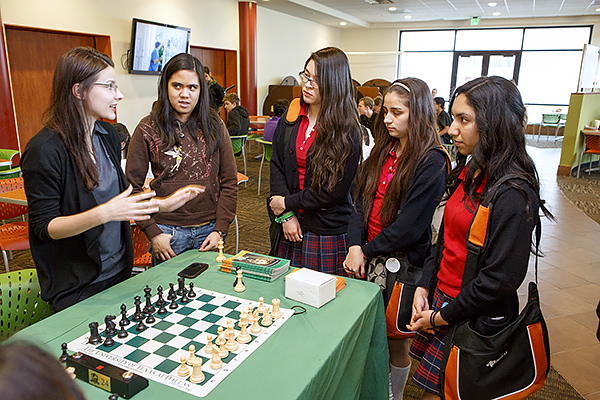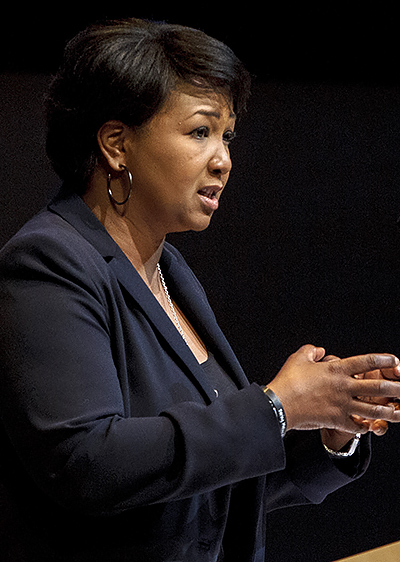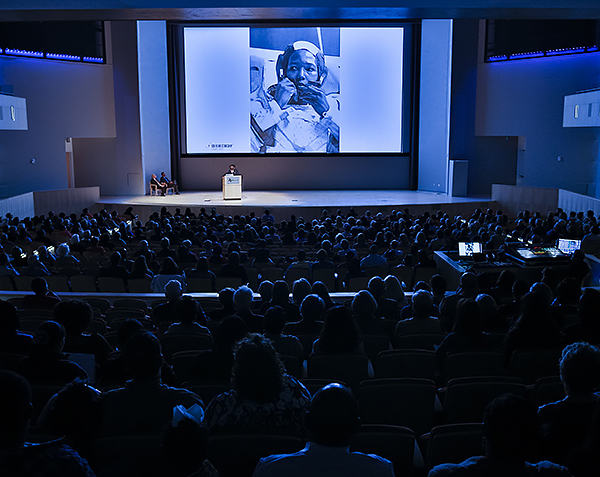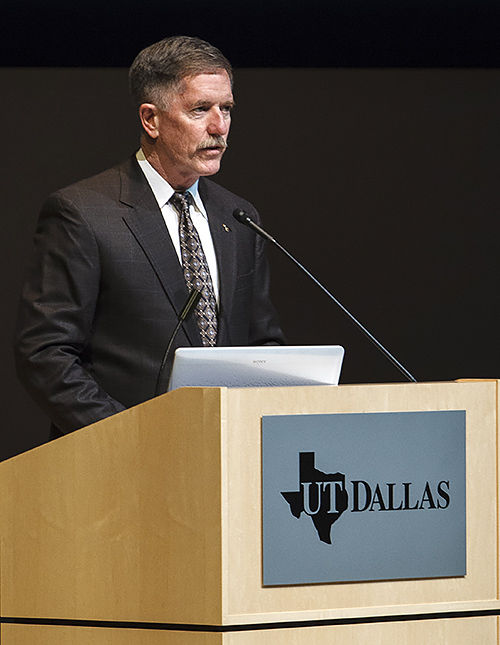
UT Dallas chess team members Patrycja Labedz, Woman FIDE Master, and Cheradee Camacho, Woman International Master, greeted teens from Irma Lerma Rangel Young Women’s Leadership School. The teens attended Mae Jemison’s lecture as special guests of UT Dallas.
Dozens of young women from Irma Lerma Rangel Young Women’s Leadership School watched from the audience as astronaut, engineer, physician and teacher Dr. Mae Jemison told her story of refusing to limit herself by holding tight to her dreams.
The girls attended the final event in the University’s inaugural ATEC Distinguished Lecture Series as special guests of UT Dallas, first meeting with female players of the renowned chess team before listening to Jemison’s talk.
Dan Williamson, a science teacher at Irma Rangel, said he brought the girls because he wanted them to see the struggles people endure to be successful.
“I want them to take pride in what someone from similar circumstances accomplished and gain hope that they too can be a success,” Williamson said.
Ashley Guevara, a junior at Irma Rangel, said she had done a project on Mae Jemison before seeing her in person and credited Jemison with teaching her about taking scientific approaches to solving problems.
“I really loved it,” Guevara said of the speech. “Mae Jemison said she was scared of heights, but she still managed to go into space. It made me realize I can go further than I thought.”
Jemison’s April 16 appearance capped a series that drew nearly 4,000 people to four lectures held in the University’s new Edith O’Donnell Arts and Technology Building. The annual lecture series will continue in the future, with the emphasis remaining on the relationships between technology, engineering, behavioral and social sciences, and art.

Mae Jemison said arts and sciences together help us understand our place in the universe.

Jemison, who flew aboard the Space Shuttle Endeavour in 1992, was the final speaker in the inaugural Arts and Technology Distinguished Lecture Series.
Other series speakers included Monument’s Men author Robert Edsel, Microsoft executive and datacenter chief Christian Belady, and Vinton G. Cerf, one of the recognized “fathers of the Internet” and vice president and chief Internet evangelist at Google.
Before Jemison’s appearance, Dr. James Reilly, a veteran space explorer and UT Dallas alumnus, welcomed the audience.
“Dr. Jemison and I have the shared experience of viewing the Earth from orbit,” said Reilly, who earned three degrees from UT Dallas: a bachelor’s, master’s and doctorate, all in geosciences.
Reilly praised his fellow astronaut for championing STEM (science, technology, engineering and mathematics) education during a time when the United States needs it the most.
“A recent international study that examined science and math proficiency among teens ranked the U.S. as 36th in the world. It is our challenge and responsibility to inspire those who follow behind us,” Reilly said. “Dr. Jemison is not only a role model, but is working to expand STEM opportunities and reverse the trends in science and math education in our nation. Hopefully her efforts will allow our successors to stand on our shoulders and carry the next generation into the unimagined future.”
In the spirit of the Arts and Technology program, Jemison spoke about her undergraduate years at Stanford University and how she was torn between following her love of dancing and her interests in medicine and science.
“I came to understand that I didn’t have to narrow myself down, to choose one or the other. I took ceramics and dance, but also investigated the powerful concepts of infinity and the Big Bang,” Jemison said.

Former astronaut Dr. James Reilly BS’77, MS’87, PhD’95 introduced Jemison.
Jemison, who was the first minority woman to go into space, showed pictures that were taken during her six years as a NASA astronaut. She also received big applause when she revealed a photo from her cameo on the television show Star Trek: The Next Generation.
Jemison also explained her current work on the 100 Year Starship (100YSS), an initiative funded by the Department of Defense’s Defense Advanced Research Project Agency (DARPA) to determine how to make space travel to another star possible within the next 100 years.
Jemison explained how space exploration drives human advancement and new technological development, and builds a global network needed to achieve interstellar travel.
“We believe that building an extraordinary tomorrow will build a better today. The reason why is because the future never just happens; it is created by either our action or inaction,” she said. “The reason why we’re doing this is because the same capabilities we need to develop to travel to the nearest star are the same capabilities we need to survive here on Earth.”
At the end of her talk, Jemison invited questions from the audience.
UT Dallas senior Darrel Dunn explained his passion for dancing, which he said expresses art and technology, and asked Jemison how to best pursue his dreams.
Jemison said he had to be ready to share his craft and then invited him onto stage to perform. Dunn hopped on stage and spun across the floor, moving with light balance, arms gesturing toward the audience.
“I’ll say the first part of that is being prepared and willing to perform at a moment’s notice,” Jemison said as Dunn walked off the stage to loud applause. “That’s the most important thing you can do.”
Michelle Cedillo, one of the Irma Rangel students, also stepped to the microphone.
Cedillo said she and many of her classmates have similar backgrounds to Jemison’s, and they have dreams, but face tough circumstances.
“Basically, I asked her what she would say to the youth. And I was surprised. Her answer wasn’t corny,” Cedillo said later.
Jemison said to focus on looking beyond struggles and that the best way to make a dream come true was to “wake up” and find steps to take toward accomplishing goals.
“I felt like she was talking to my classmates and me,” Cedillo said. “Some things from her talk have really stuck with me, like her call to push for further understanding and to reconsider the way we approach difficult problems.”